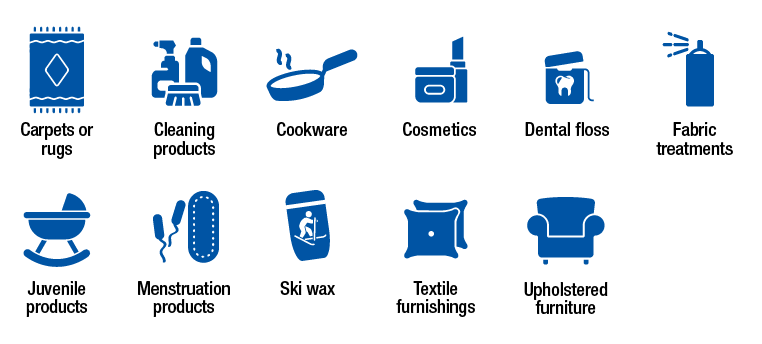PER- AND POLYFLUOROALKYL SUBSTANCES
Reducing sources of PFAS in water and wastewater
Per- and polyfluoroalkyl substances (PFAS) are a group of more than 5,000 manufactured chemicals. Some PFAS are toxic to humans. Their unique properties like resistance to heat, water, and oil, made them popular for manufacturers worldwide to use in numerous products people use every day. The chemicals do not break down in the environment and have been found in groundwater and surface water in Minnesota.
Because of their widespread use in products, PFAS are entering waste streams and going to wastewater and solid waste facilities where the chemicals are difficult and expensive to address. Testing has found PFAS in wastewater at Met Council facilities. Current wastewater treatment technologies at our nine water resource recovery facilities are not designed to remove PFAS before water is returned to the environment. If we need to implement removal technology, the cost will be passed on to users of the sewer system.
Businesses can do their part to protect health. They should:
- Remove PFAS from the products they manufacture
- Discontinue use of PFAS-containing products
- Dispose of PFAS-containing products appropriately
Minnesota PFAS prohibitions
Businesses need to plan for PFAS prohibitions as part of the Minnesota PFAS Blueprint to prevent, manage, and clean up PFAS pollution.
- July 1, 2020: Firefighting foam for testing or training
- Jan. 1, 2024: Firefighting foam and food packaging
- Jan. 1, 2025: Intentionally added PFAS in 11 product categories
- Jan. 1, 2032: All products which contain intentionally added PFAS, unless determined to be unavoidable
PFAS in 11 categories of products

PFAS source reduction for industries
Preventing PFAS pollution is the most effective way to address health risks. You should understand the various types of PFAS, including PFOS, PFOA, PFBS, PFHxS, PFNA, and HFPO-DA. These tools developed by the Minnesota Pollution Control Agency can help businesses determine how to find PFAS in their products.
As a buyer
- Start working with your suppliers to purchase products that are PFAS free.
- Review Safety Data Sheets (SDS) to see if PFAS is listed, by any variation of PFAS type or their abbreviations. If you see “fluoro” in any ingredient name, the product contains PFAS.
- If any ingredients are listed as “trade secret” or “confidential”, ask the supplier if the product contains PFAS.
- Ask your suppliers to provide certification that products are PFAS free. If included at extremely low amounts, PFAS might not be listed on the SDS.
As a seller
- Start working on your plan to remove PFAS-containing products from sale.
- Notify retailers about products prohibited starting in 2025.
- Apply for third party certification that your products are PFAS free.
PFAS product survey for industries
Met Council is asking all permitted industries to complete and submit a PFAS product survey to the Industrial Waste and Pollution Prevention (IWPP) section.
On the survey, industries will report :
- Their facility’s PFAS risk as determined using the MPCA’s PFAS desktop screening tool
- All PFAS containing products used or stored at the facility
- The purpose and frequency/quantity usage of the PFAS containing product
- The potential for the PFAS containing product to be sewered
- Any known PFAS product substitutions
Met Council PFAS product survey (Excel)
Instructions for completing the Met Council PFAS product survey (PDF)
IWPP is compiling a a list of PFAS containing products reported in the surveys we receive.
PFAS disposal
Current wastewater treatment technologies cannot remove PFAS. Do not dispose of any PFAS-containing products in the sanitary sewer or in a septic system. The Minnesota Pollution Control Agency provides guidance on disposing of PFAS products.
Disposing of PFAS containing products
Do not dispose of any liquid products in the sanitary sewer or a septic system.
| Solid waste |
Hazardous waste |
Carpets/rugs
Cookware
Cosmetics and personal care products
Dental floss
Food packaging
Juvenile products
Menstruation products
Textile furnishings
Upholstered furniture
Water resistant fabrics
|
Class B firefighting foam concentrate
Cleaning products
Liquid/spray fabric treatments
Ski wax |
Source: Minnesota Pollution Control Agency